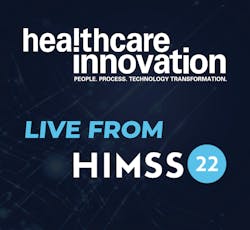The top two healthcare policy officials in the federal government spoke remotely to the audience gathered at HIMSS22 in Orlando, remotely from Washington, D.C. on Tuesday, March 15, confirming previous statements on the policy direction of the Department of Health and Human Services (HHS) and the Centers for Medicare and Medicaid Services (CMS), but largely breaking no new ground.
HHS Secretary Xavier Becerra and CMS Administrator Chiquita Brooks-LaSure spoke via video link to an audience gathered in Chapin Hall on the third floor of the Orange County Convention Center during the second full day of HIMSS22; both appeared from their offices in Washington, D.C.; they interacted with Tom Leary, senior vice president, government relations for HIMSS (the Chicago-based Healthcare Information & Management Systems Society), the sponsor of HIMSS22.
Becerra’s address was brief, a little over about five minutes. He saluted the work of the healthcare IT leaders in the audience, saying that “You’re in the audience today because you understand that every patient as the right to their information… and you know the consequences of not being able to access that information; it can be devastating, and even deadly. At HHS, we stand with you. Over the past year, we’ve made extraordinary progress in advancing health equity, in putting into action the provisions of the 21st Century CURES Act, and launching TEFCA, less than a year after President Biden came into office,” he said, referencing the 21st Century CURES Act of 2016 and the Trusted Exchange Framework and Common Agreement.
Becerra emphasized that “We’re putting health equity at the center of every decision we make,” and noted that work is underway to update the federal minimum data standards to include health equity data. He also said that “It’s time to get that done,” citing the provider penalty for information-blocking under the CURES Act, something that was provided for in the Act, but has not yet been developed or implemented. He noted that “Over 75 percent of complaints have been against providers, most by patients.” Indeed, he said, citing one example, “One patient reported that they were waiting for the results of a biopsy, and those could only be released by phone, and could only be released later, after the provider had returned from out of town. That’s just one of hundreds of complaints we’ve received so far. Closing this enforcement gap is an HHS priority.” And, he noted, “We’re working on a federal public health equity initiative, and developing a program of health equity by design.” Further, he noted, “I’ve asked ONC to take a deep look at algorithmic bias,” referencing the Office of the National Coordinator for Health IT.
Brooks-LaSure began her address by stating that “I’ve been thinking a whole lot about all we’ve been going through and continue to go through during the COVID-19 pandemic. I’ve been generally reflecting on what a challenge it’s been for our country. Similar to the passage of the ACA,” she said, referencing the Affordable Care Act—and she worked in the Obama administration as the ACA was being developed—"we were at the beginning of the Great Recession” in 2008, when the ACA was first being developed. “And I remember when we started talking about health reform, and people asked how we could address health reform when we were going through an economic crisis. But at the time, one of three bankruptcies was because of medical debt,” referring to the commonality between the two situations. “And while it’s been a challenging time, we have a new awareness of what health disparities and inequities mean for us as a country, and how they affect all of us, and how we need to partner together to address these underlying issues, so everyone can live the life we want.”
Further, as she said, referencing President Joe Biden, “The President has made it clear we’re going to address health equity through a whole-of-government approach. At CMS, that’s our first question, not our last one. It’s imperative to us that we lift up underserved communities. And that everyone have access to affordable, high-quality healthcare services. No American should be left behind when it comes to better health, health insurance, and health insurance.”
Brooks-LaSure emphasized to the audience—as she has stated previously—that CMS will move forward focused on six policy pillars, which are:
Ø To advance health equity by advance addressing health disparities
Ø Building on the ACA and expanding access to Medicare, Medicaid, CHIP, and the marketplaces
Ø Addressing issues throughout the process of regulation
Ø Promoting value-based, person-centered care
Ø Protecting the Medicare program’s sustainability through future generations.
Ø Fostering a positive, inclusive workplace, and promote excellence
“Taken together, we hope that these strategic pillars will address the issues in our healthcare system,” Brooks-LaSure told the audience. “COVID-19 exposed the challenges facing the ability to easily share information. As Secretary Becerra said in his remarks, the consequences can be devastating, even deadly.”
Meanwhile, with regard to healthcare IT, Brooks-LaSure said that “CMS remains connected to advancing health IT and interoperable health data exchange. Our policies will help lay a firm foundation” for interoperability going into the future. “We’re working towards our goal by increasing and advancing healthcare data exchange, to … support and improve care, by supporting providers and payers,” and investing significantly in interoperability for the U.S. healthcare system.”
Referring to the Interoperability and Patient Access Final Rule that CMS published in 2020 and modified in 2021, Brooks-LaSure said, “This rule helps insure that patients have access to their health data. But we need to go much further to help patients make use of that data. The rule also established a requirement for payers to share data with other payers, particularly when consumers changed health plans. The policy that CMS finalized did not quite hit the mark. Because we didn’t require standardized API use, the interoperability rule wasn’t interoperable enough. It’s vital that policies support people in ways they need, and that payers be able to support. We’re working on additional rulemaking with our payer data exchange policy, encouraging use of the FHIR [Fast Healthcare Interoperability Resources] standard. We’ll be incorporating extensive public feedback to make our policies better and stronger,” she said. “And because of your feedback, we will publish a rule for enhanced data exchange. This will be shared soon.”
Indeed, Brooks-LaSure told the audience, “Our first interoperability rule was just a first step in supporting healthcare data exchange. While CMS works to develop rulemaking on interoperability and payer-to-payer data exchange, we’re also already engaged on our approach to digital quality measures. Digitizing our measures will not only reduce the burden on providers, but will also allow us to do more analytics.” And she repeated Becerra’s stated commitment to publish provider information-blocking penalties as soon as possible.
“We’re also exploring how TEFCA can be used to support a variety of CMS use cases,” Brooks-LaSure said. “As we work with ONC, we will continue to look at ways to support things like prior authorization. ONC recently published a request for information around prior authorization, and that very much aligns with CMS goals in this area. Person-centered design approach towards prior authorization. We want to see prior authorization that works for people and reduces burdens on providers and payers. We’re also looking at a standardized API, based on FHIR. FHIR is already being used … allowing advanced consumer-friendly explanation of benefits to be used. Ultimately, we want to improve and enhance health equality for individuals. And FHIR is critical.” And, “Finally” she said, “we’re taking a close look at the challenges of provider directories, and looking at what role CMS should play in managing such a directory, and we’re looking forward to hearing from you.”
Ultimately, she said, “We’re working towards a vision of a data-connected healthcare system that better supports people and enhances the health and well-being of all Americans. We know at CMS that we can’t do it alone. It is our role to work with our partners in industry, academia, and healthcare. Leaders, we want to hear from you. Above all, we want to be your full partners.”


